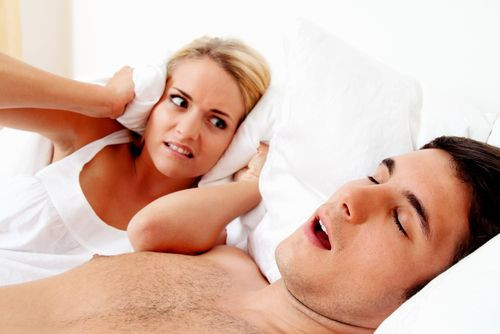Sleep Apnea May Increase Pneumonia Risk; CPAP May Increase Pulmonary Aspiration, Bacteria

The loud snoring sounds we hear from a bed partner or family members in the next room can be obtrusive and may interfere with a good night’s sleep for us — and the snorer. Frequent loud snoring can interrupt breathing, or cause it to be very shallow, resulting in breathing pauses that can occur up to 100 times a night, an indicator of obstructive sleep apnea (OSA). Although continuous positive airway pressure (CPAP) is the “gold standard” treatment for sleep apnea, it could be increasing the risk of a lung infection. According to a study published in the Canadian Medical Association Journal, sleep apnea poses a high risk of pneumonia potentially due to the decrease in coughing up mucus from the lungs, an increase in pulmonary aspiration, and bacterial contaminants in CPAP.
Adults with moderate to severe sleep apnea rely on PAP machines to keep their airway from collapsing during sleep. The most common treatment — CPAP — increases the air pressure in the airway by using a small, quiet air blower device that is typically connected through a hose to a nasal pillow, nose mask, full-face mask, or hybrid. CPAP has been the most widely used and successful treatment for sleep apnea, but some medical experts believe it could be doing more harm than good.
A team of Taiwanese researchers believe patients with sleep apnea patients face a high risk for the emergence of pneumonia because they are more likely to be immune to perturbations — or mental uneasiness — which can make them susceptible to pathogens. Since most research has solely focused on the risk of pneumonia in CPAP patients and children, the team sought to explore the incidence of the condition among adults with sleep apnea, with or without the need for CPAP therapy. Data was drawn from the Taiwan National Health Insurance Research Database to identify adult patients with sleep apnea from January 2000 to the end of December 2010 in the large cohort study.
Over 6,000 adults from Taiwan who were newly diagnosed with sleep apnea were included in the study, according to Medical Xpress. All of the sleep apnea patients were older than 20, with an average age of 55 years old. These patients were compared to a control cohort without sleep apnea that was matched for age, sex, and other chronic or long-term conditions such as Parkinson's disease, kidney disease, cancer, and asthma, among many others. None of the participants had a medical history of pulmonary infection, and the researchers conducted follow-ups after five years.
The findings revealed adults with sleep apnea were 20 percent more likely to be diagnosed with pneumonia compared to the control group. Those who needed CPAP therapy had a 32 percent increased risk compared to the control participants. Meanwhile, 15 percent of sleep apnea patients who didn’t need CPAP therapy faced a 15 percent increased risk. Overall, the patients who developed pneumonia were older, and most had sleep apnea along with diabetes, heart disease, and other co-occurring conditions.
"This study showed that sleep apnea is an independent risk factor for incident pneumonia," wrote Drs. Vincent Yi-Fong Su and Kun-Ta Chou from the Department of Chest Medicine, Taipei Veterans General Hospital, Taipei, Taiwan, with co-authors, according to the press release. "Our results also demonstrated an exposure–response relation in that patients with more severe sleep apnea may have a higher risk of pneumonia than patients with sleep apnea of milder severity." The more severe the sleep apnea, the more likely the patient will need CPAP therapy, increasing their pneumonia risk.
The study authors speculated the increased risk could be attributed to patients’ susceptibility to aspirating contents or liquid from the throat. The obstruction of breathing properly during sleep can allow the entry of foreign material such as food or drink from the oropharynx or gastrointestinal tract into the voice box, or larynx and lower respiratory tract to the lung. Moreover, the use of CPAP may reduce the ability to cough up mucus from the lung and increase pulmonary aspiration. CPAP equipment can be the breeding ground for bacterial contamination that can lead to the emergence of pneumonia, the authors wrote.
Therefore, it is essential to keep CPAP and other equipment clean to maintain good health. Daily cleaning of PAP devices should be done to remove dirt and oils. Bacteria can grow and build up and lead to infections, especially in airway passages and lungs such as pneumonia. According to the American Lung Association, the condition, along with influenza, remains the eighth leading cause of the death in the U.S. It is characterized by virus, bacteria, and other organisms in the body but can be caused by inhalation of food, liquid, gases, or dust.
Sleep apnea is a prevalent condition that affects an estimated 22 million Americans, with 80 percent of moderate and severe cases going undiagnosed. The American Sleep Apnea Association says the condition occurs when the tongue collapses against the soft palate and the soft palate collapses against the back of the throat during sleep, causing a blockage of the airway. The throat becomes very relaxed and interferes with a sleeper’s breathing. Those with severe sleep apnea will experience this multiple times a night during rapid-eye-movement (REM) sleep and will see a reduction in their blood-oxygen levels, taking a toll on the sleeper’s physical system.
Source: Chang SC, Chen TJ, Chen YM, et al. Sleep apnea and risk of pneumonia: a nationwide population-based study. CMAJ. 2014.



























